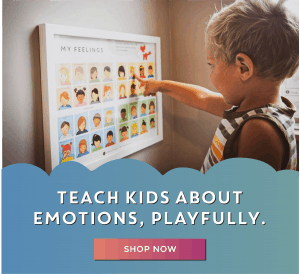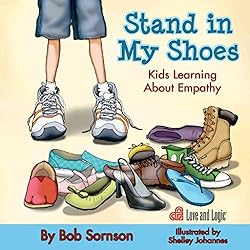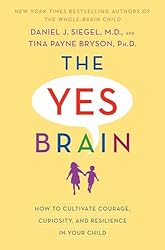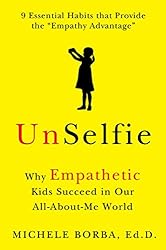[ad_1]
Sneak peek: The event of social expertise and perspective taking in youngsters is a type of milestones that usually will get ignored. By understanding this hidden a part of mind improvement, we’ve perception into a vital a part of the beginnings of empathy.
As mother and father, I believe one among our important targets is to assist our kids develop an understanding and empathy for different individuals. If you’re the father or mother of a toddler, that instilling this concept of empathy appears an nearly not possible job. There’s a superb cause for that–it is nearly not possible for a toddler. Most of us know that toddlers (underneath about 4 years of age) merely don’t have the cognitive or social-emotional improvement expertise to grasp what different individuals is likely to be feeling or considering–a side of social expertise often known as perspective taking.


*This submit comprises affiliate hyperlinks. Buying by way of these hyperlinks helps assist this weblog at no added value to you.
This job is what psychologists name Idea of Thoughts–that’s the capacity to grasp or anticipate what one other individual is feeling or considering. In different phrases, it’s the power to place your self in another person’s footwear. That is a part of a set of social expertise that’s the foundation for empathy but additionally is essential in youngsters studying issues like sharing and serving to others.
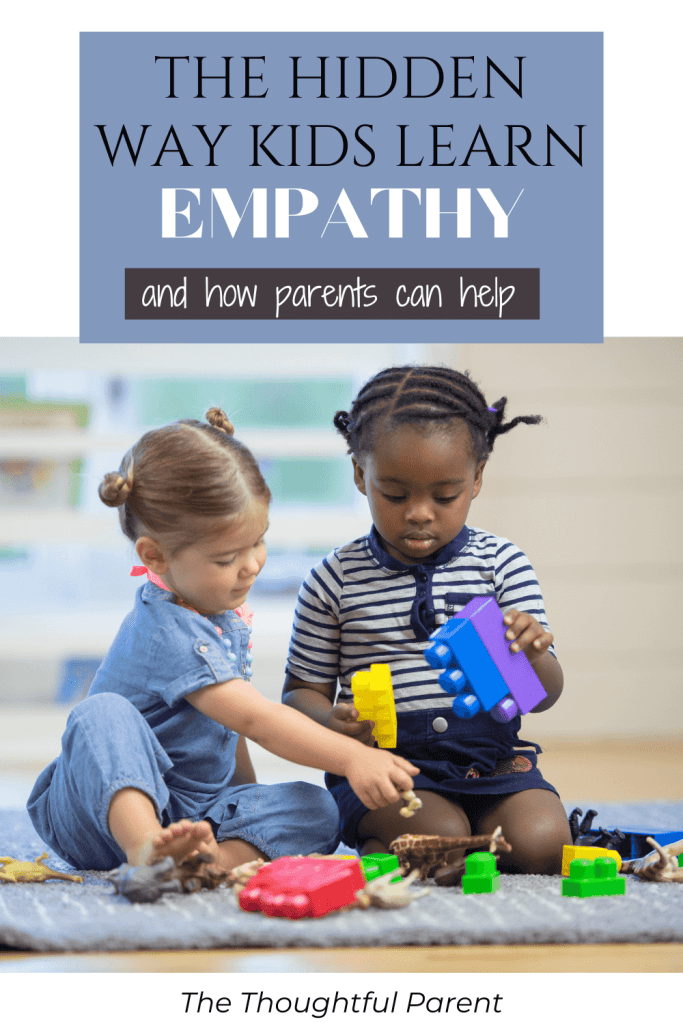
At What Age Do Youngsters Develop Perspective Taking?
So how do youngsters be taught this necessary talent of taking one other individual’s perspective? Researchers have lengthy believed that this capacity develops in most children round 4 years of age. This video provides a fantastic instance of the distinction between a 3 and 4-year-old in perspective taking capacity (additionally referred to as Idea of Thoughts):
After viewing this video, it’s nearly as if one thing magical occurs between age 3 and 4 that helps youngsters be taught this talent. In a way, that is true. Youngsters’s brains are consistently altering and making new circuits that make new thought processes potential. Nevertheless, new analysis is displaying that that how mother and father discuss to their youngsters can also help on this perspective-taking capacity.
Perspective Taking: Phrases Matter
A latest examine revealed within the journal Little one Improvement confirmed that youngsters whose mother and father described extra about how different individuals is likely to be feeling or considering had higher perspective-taking expertise than these whose moms didn’t use this descriptive language.
In some respects, this examine appears sort of apparent. You’ll anticipate that speaking to a baby about taking one other individual’s perspective would assist them be taught this capacity. If you actually take into account this, although, it’s fairly superb. The cognitive talent it takes for a teen to grasp the attitude of one other individual is fairly complicated and to suppose that only a father or mother speaking to them about this influences how rapidly they be taught this talent.
You might also get pleasure from: Social-Emotional Improvement: The Final Information for Mother and father
The opposite compelling side of the examine is the discovering that youngsters who had delays in language acquisition additionally had delays in perspective-taking capacity. This offers additional proof that the hyperlink between language and perspective taking capacity is an actual one. The researchers consider that particular points of language acquisition (e.g., studying possessive phrases) assist youngsters achieve the cognitive flexibility wanted to take one other individual’s perspective.
How Do You Observe Perspective Taking?
1. Level out different youngsters’s feelings whenever you see them.
Even younger youngsters are very conscious when different youngsters get damage or are upset. Does your baby discover or appear involved when she hears one other baby crying? Use this as a studying alternative–discuss to your baby about how the opposite baby is likely to be feeling. For instance, you would ask, “Why is that little boy unhappy? Do you suppose he’s unhappy or indignant? What do you do when you’re unhappy?”
2. Books can train classes.
Children have a tendency to note small particulars about social expertise and perspective-taking in books that we would miss. They usually ask issues like, “Why is that bear unhappy?” or “Why is that woman laughing.” Reap the benefits of these conditions and clarify the feelings you’re seeing within the story. Take a look at this on-line bookshelf for sources on toddler emotional improvement.
3. Speak about feelings at residence.
Mother and father have combined emotions about displaying an excessive amount of emotion in entrance of youngsters. We typically wish to put up a “sturdy entrance” and never let our children see us cry or really feel unhappy. I believe there may be some worth to this—we don’t need to burden our children with points that might not be acceptable for his or her developmental stage. Nevertheless, I don’t suppose it’s burdensome to let our children see us as emotional beings on occasion. After we expertise the lack of a liked one or are frightened a few buddy, our children will in all probability discover our change in temper. In the event that they ask, you’ll be able to take the time to elucidate why you’re unhappy (in kid-appropriate phrases). This may give them a bit extra perception and empathy in your emotions and people of others.
4. Concentrate on setting boundaries on conduct, not feelings.
As this nice article factors out, one key to authoritative parenting (which, by the way in which, is related to favorable impacts for youths) is setting boundaries and limits on their conduct, not their feelings. Enable youngsters the emotional freedom to really feel how they really feel, even when it’s ugly at occasions (howdy tantrum). Analysis continues to point out that probably the most efficient mother and father don’t induce guilt journeys or psychological methods. Reasonably, you’ll be able to set a agency restrict on conduct and assist youngsters deal with the feelings that will comply with. Over time, this expertise with genuine emotion (and steerage from you) will assist them perceive the feelings of others.
5. Faux play and function play.
Younger youngsters love fake play and it simply so occurs it’s an superior method to encourage perspective-taking expertise. Give it some thought—when a baby pretends to be one other individual or character, they’ve to grasp (a minimum of a bit) that individual’s emotions and actions. That is perspective taking in motion! They’re actually placing themselves into another person’s footwear to fake to be that individual. Encourage and foster fake play in younger youngsters in any manner you’ll be able to. You may ask your preschooler how the individual they’re pretending to be would really feel or act in several conditions. Enjoyable and studying are all wrapped in a single exercise!
Peacemakers: A easy sport designed to nurture social and emotional expertise, self-love, a development mindset, 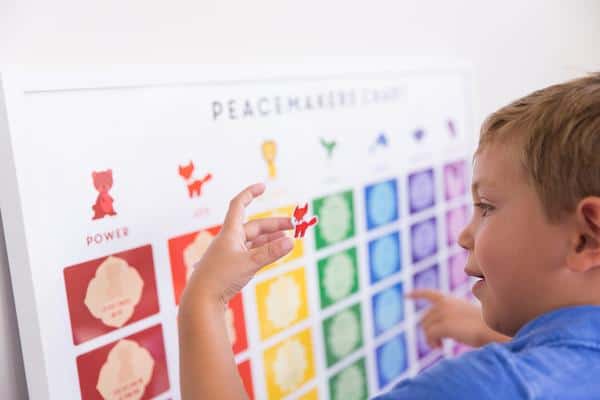
Though this examine is attention-grabbing, it’s value noting {that a} baby does nonetheless need to have a sure diploma of cognitive improvement as a way to foster perspective taking and empathy. Regardless of how a lot you discuss to your 2-year-old about how one other individual is feeling, they most certainly will not be going to essentially perceive the opposite individual’s perspective. This use of description language, nevertheless, will hopefully assist your baby later after they have the cognitive maturity to understand the concept of taking one other individual’s perspective.
Associated studying: Self-Regulation in Toddlers: Why Language Issues Extra for Boys
Wish to perceive extra about baby improvement milestones and find out how to assist your baby? Join The Considerate Dad or mum publication on Substack.
Associated Sources:
Supply: Farrant BM, Maybery MT, & Fletcher J (2012). Language, cognitive flexibility, and express false perception understanding: longitudinal evaluation in typical improvement and particular language impairment. Little one improvement, 83 (1), 223-35 PMID: 22188484
[ad_2]
Supply hyperlink
